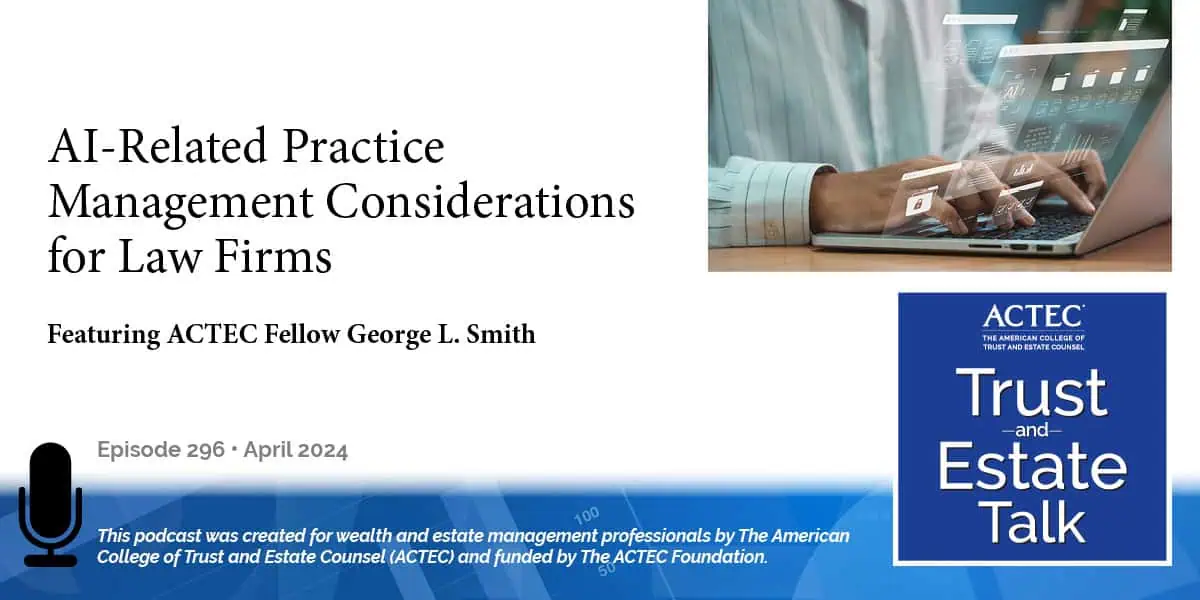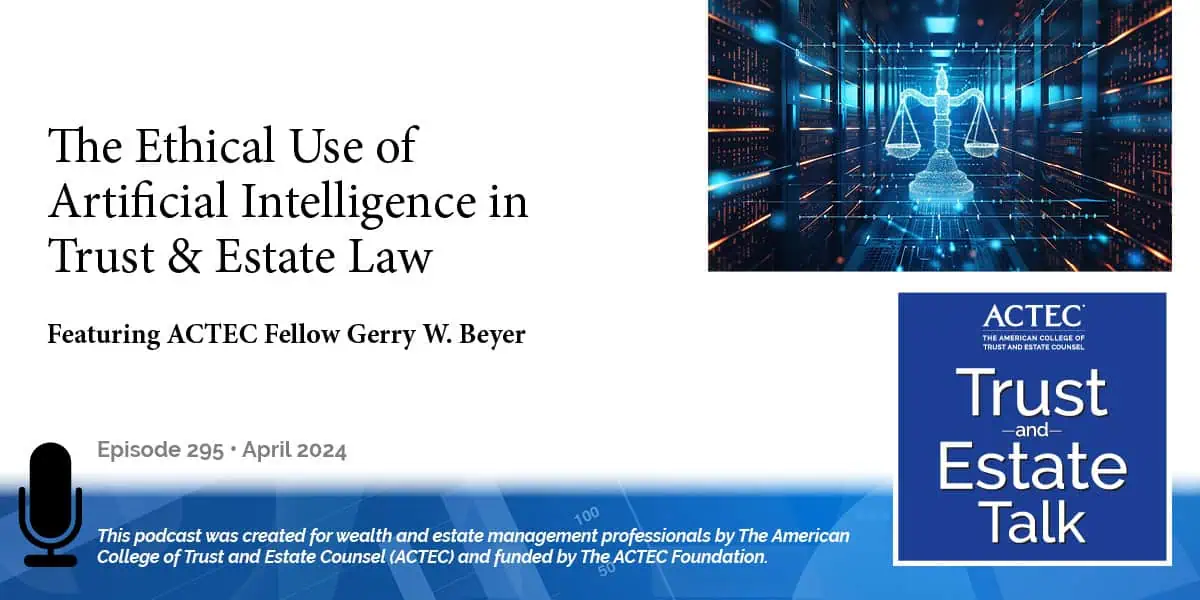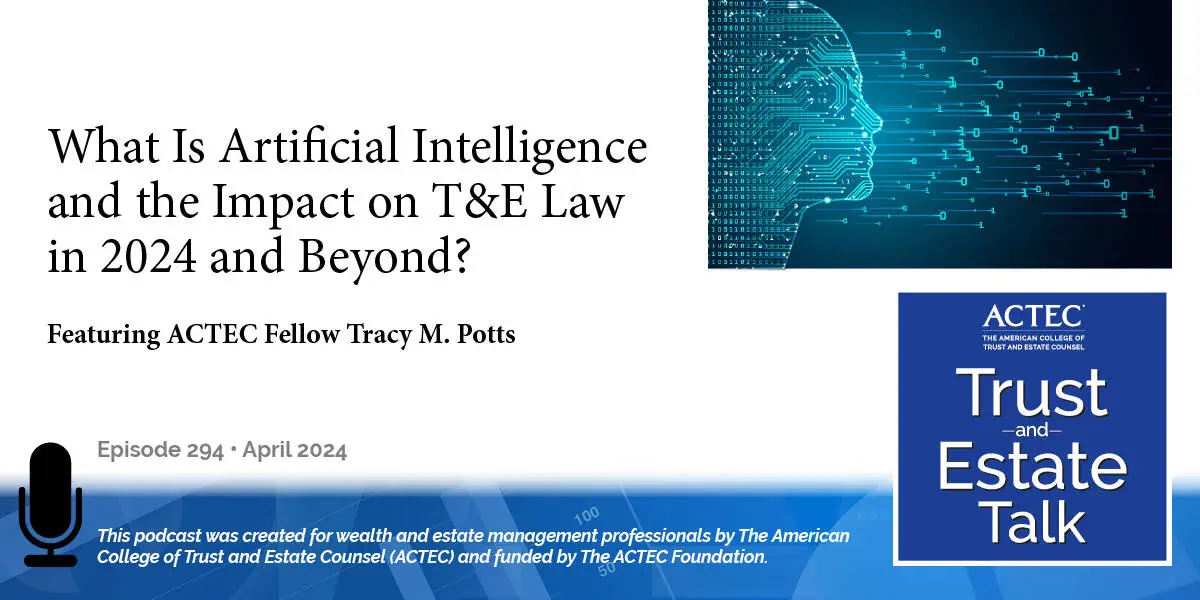The IRS is Here to Help: How Does That Happen?

“The IRS is Here to Help: How Does That Happen?” That’s the subject of today’s ACTEC Trust and Estate Talk.
Transcript/Show Notes
This is Doug Stanley, ACTEC Fellow from St. Louis, Missouri. Estate planning experts are here to share how practitioners can get Private Letter Rulings (PLR) and other advice from the national office. ACTEC Fellows Beth Kaufman of Washington, D.C., and Justin Miller of San Francisco are with us today to offer their recommendations to estate planning professionals. Welcome, Beth and Justin.
Justin Miller: Well, thank you, Doug. Now, normally, people do their best to avoid any type of interaction with the IRS. But there are certain times when the IRS can actually be really helpful. For instance, sometimes we need an answer but the tax rules are unclear. I don’t know if anyone else has ever had that experience before. So, when might the IRS National Office be a resource and how does the whole Private Letter Ruling, or PLR, process, work? And with that, I’ll turn it over to Beth.
Private Letter Rulings (PLRs)
Beth Shapiro Kaufman: Thanks, Justin. So, a Private Letter Ruling is a great opportunity to get the IRS’s view in advance on the tax consequences of a planned action or transaction. In the estate and gift area, we see lots of Private Letter Rulings in the generation-skipping transfer tax area. For example, when people are thinking of modifying, amending, or decanting a trust and they want to make sure that it doesn’t have any adverse GST effect, they often ask for a Private Letter Ruling.
The other thing we see a lot of in the estate and gift area is something called 9100 relief, where a taxpayer can come in and ask for permission to make a late election of some sort with retroactive effect. So, we see that often, again, in the GST area. For example, you meant to opt-out with respect to a trust and you can make a late opt-out election and have that effective when you meant to make it. Or, you meant to make a QTIP election on an estate tax return and you somehow missed it and you can get permission to do that late. So, these are really helpful results that are available through the Private Letter Ruling process.
Limitations to PLRs
Justin Miller: Alright, so, PLRs sound great. But are there any kind of limitations, or issues, where we can’t get a PLR?
Beth Shapiro Kaufman: There are. There are a bunch of situations in which you can’t get a PLR. For example, if the return is already under examination, you can’t get a PLR, generally. If your issue is a factual issue, they won’t rule on that. If you’re only asking about a part of an overall integrated transaction, they won’t give you a ruling on part of a transaction, they want to see the whole thing.
And then there are a bunch of issues that are listed in the annual Rev. Proc– this would be Rev. Proc. for this year 2023-3- it lists “no rule” areas. Some examples of that in our field are: The IRS won’t rule on whether a grantor is an owner under the grantor trust rules, they won’t rule on ING trusts, they won’t rule on whether there are estate tax inclusion consequences to using a private trust company as your trustee, and they won’t rule on anything right now dealing with decanting.
The IRS also won’t give what they call a “comfort ruling.” That means if the answer is already clear from the authorities that are out there, they don’t want to waste their time– and your time– issuing a Private Letter Ruling on that. They won’t rule on frivolous or groundless issues, or what they call “fringe” positions, which is like, “The entire tax code is unconstitutional,” or something like that.
Initiating the PLR Request Process
Justin Miller: Alright. So, let’s say we have something that qualifies for a Private Letter Ruling; I’ve got a client that wants to move forward. What’s the process for initiating that PLR request?
Beth Shapiro Kaufman: Okay. First of all, I would note that there are things you can do before you request a Private Letter Ruling. You can always pick up the phone and call the people in branch four at the national office and just ask them a question informally. We are really fortunate in that the branch that we deal with at the IRS is very friendly and helpful and they’ll answer the phone and they’ll answer informal questions. So, sometimes you can just get an answer to your question by making a phone call, and then go forward and on your merry way.
If you think you’re going to want to apply for a Private Letter Ruling, there’s also a process through which you can have a pre-submission conference. So, let’s say I want a ruling on something and I’m not sure it’s an area the IRS will rule in. I can call and ask for a pre-submission conference. I have to submit some details about the taxpayer and the issue, and then they’ll have a preliminary conversation with me, and discuss the likelihood of success for what I’m asking for and whether they’re willing to rule on it.
Sometimes they even say: “Well, you’ll be better off …” Let’s say I’m trying to modify a trust in some way, they’ll say: “Well, go get your state court reformation first, and then come back to us for the ruling.” So, they do give very helpful advice like that in a pre-submission conference.
Once you decide to go forward, you need to submit a written request for a Private Letter Ruling. The things that are contained in that request are in the -1 rev. proc. for each year. So, this year is 2023-1 Revenue Procedure. And they even have kind of a skeletal model of what your submission should look like. Basically, you have a factual section, and you want those facts to be written in a persuasive fashion. I always like to think of it as I’m telling a story, and I want to tell the story in the best light that I can, and in the most persuasive manner that I can.
Then you need to say what rulings you’re requesting, what your legal positions are, and what your arguments are. So that part is like a brief, where you’ve got argument headings, and then you lay out your authorities and the reasons why the ruling should be granted. If you’re doing an application for 9100 relief, you often need to attach affidavits from various people who were around when the election wasn’t made to try to explain why it wasn’t made and why it’s a good case for relief.
There are some checklists that apply. One of the checklists is always Appendix C to the -1 rev. proc. But also, in the estate and gift area, you often have to attach Rev. Proc. 91-14, which has questions that specifically pertain to estate and gift issues. Then you’ve got to pay a user fee and the user fee has gotten quite expensive in recent years. For most of our ruling requests, the user fee for 2023 is $38,000. If the taxpayer meets certain income qualifications, that rate can be reduced. And for 9100 relief, the rate is a mere $12,600, which doesn’t sound so bad compared to the $38,000.
Those costs increase every other year, so if you’re thinking of asking for a ruling request and it’s getting toward the end of the year, you might want to get the request in before the rates go up. You need a penalties of perjury statement signed by the taxpayer and then you take that whole package and fax it or mail it to the IRS.
IRS Response and Resolution
Justin Miller: All right. Well, let’s say we’ve done all that on the taxpayer’s side. We’ve followed the checklist and we’ve paid our big fee. Let’s pull back the curtains. What now happens on the IRS side?
Beth Shapiro Kaufman: So, when the package comes in, somebody looks over it to make sure that it’s complete, and then it gets assigned to one of the attorneys in Branch 4, assuming it’s an estate and gift matter, which I think is safe to assume for this audience. The attorney will contact the lawyer within 30 days of receiving that package and just tell you that everything looks to be in order and give you some sense of how big that attorney’s pile of work is and when you might expect to hear back from them again.
Branch 4 has an internal rule where they agree that they will give you an answer within six months of when you file the ruling request and they’re really very good about sticking with that. So, once you filed, you can feel pretty certain that you’ll have this resolved one way or the other in a six-month period. The attorney might call with some additional questions. If they ask for you to submit either answers to those questions or additional documentation, you generally get a 21-day period in which to do that.
If they come back to you and say that they’re thinking that they’re negative on what you’ve asked for a ruling about, then you can get a conference as of right. You just have to say, “Well, I would like to have a conference with you on that,” and then they’ll schedule the conference and you have an opportunity to discuss the issues with them. And there are times when I’ve been able to convince them to give a favorable ruling even after they’ve intended to plea adverse, to begin with. So, it’s definitely something you should take advantage of.
If you have an adverse conference and you can’t convince them to be favorable, you can still ask to withdraw the ruling request after that. And that brings us to kind of an interesting fact, which is that although the possible outcomes for a ruling request include a favorable ruling, an unfavorable ruling, or a no-rule, meaning they just decide they’re not going to rule on the issues that you’ve asked about, you hardly see any unfavorable rulings.
And that’s not because the IRS is a pushover and they just give all the rulings that are requested, it’s because generally, taxpayers will withdraw the ruling request if the answer is going to be adverse. Sometimes people worry about whether going to the IRS with a Private Letter Ruling request is going to result in their return being examined. That’s, of course, a possibility, but in practice, I don’t see that happening.
Technical Advice Memorandum (TAMs)
Justin Miller: All right, thank you, Beth, that was a great brief summary of Private Letter Rulings. But that’s not the only type of IRS guidance out there. What about a Technical Advice Memorandum, or TAM, T-A-M? Where do those come from, and how are they different than PLRs?
Beth Shapiro Kaufman: That’s a great question, Justin. So, when you’re reading Private Letter Rulings, a TAM and a Private Letter Ruling really look the same. You have to look carefully at it to see when you’re reading a TAM and not a Private Letter Ruling. But their origins are really completely different. As we’ve just been discussing, a Private Letter Ruling results from a taxpayer coming to the IRS with a question. A TAM comes out of an examination.
So, the IRS agent who’s conducting an examination can request assistance on any technical or procedural question that arises during the examination process. So, it’s the field, the IRS examiner, who requests technical assistance from the national office when the application of the law to the facts involved is unclear. It can’t be something hypothetical or prospective because it’s already an issue in an examination.
So, in the TAM process, the taxpayer is given the opportunity to participate, but the taxpayer can’t demand that something be sent to the national office. They say taxpayer participation is preferred– if you’re representing the taxpayer and the field suggests that you should go for a TAM, you definitely want to participate. You don’t want to turn down that opportunity to tell the taxpayer’s side of the story to the national office.
So, what happens is that the IRS and the taxpayer’s representative both prepare a version of the facts and their legal arguments, and those documents go to the national office for consideration, and then the national office issues what looks a lot like a Private Letter Ruling, but it’s a Technical Advice Memorandum addressed to the field.
Limitations and Eligibility for TAMs
Justin Miller: All right, similar to Private Letter Rulings, I’m sure there are some limitations. So, are there situations or circumstances in which the technical advice process is not available?
Beth Shapiro Kaufman: There are a couple of circumstances where it’s not available. Something that requires 9100 relief can’t be done through the TAM process. They won’t take frivolous issues, and they won’t issue a TAM in a case that’s already docketed in the tax court.
TAM Request and Resolution Process
Justin Miller: All right, great, thank you. And last question on the TAMs. If the field goes ahead and asks for technical advice, what’s the process?
Beth Shapiro Kaufman: So, the process is very much like the PLR process except that the inputs to the national office are coming both from the IRS field examiner and from the taxpayer. The national office can raise new issues if they see issues in there that neither the exam nor the taxpayer have raised, and then here, you’re going to get an answer. It’s not like with the PLR, where you can withdraw if you don’t like how it’s going. You’re either going to get a favorable or an adverse answer out of this process once the IRS has agreed to give technical advice.
Chief Counsel Advice (CCAs)
Justin Miller: Alright. So, we’ve covered PLRs, we’ve talked about TAMs, but what about CCAs, or Chief Counsel Advice? I mean, is the IRS just making up acronyms at this point? How does that type of IRS guidance happen?
Beth Shapiro Kaufman: It’s not just an acronym, Justin. Chief Counsel Advice is really different, again, than a TAM. The way you would get Chief Counsel Advice is when the field consults IRS Chief Counsel on a legal issue without the taxpayer’s participation. The field alone writes up the facts and the national office makes the legal analysis. And often this occurs in cases that the IRS thinks are headed for litigation. So, if you’re the reader and you’re reading a CCA, a Chief Counsel Advice, bear in mind that the person in the national office who wrote that was only given the government’s point of view. The taxpayer didn’t participate. So, view it as the IRS’s trial run at their brief when you read a CCA.
Considerations When Reviewing CCAs
So, let me just give you an example. I had a case where in the end, two CCAs were written on our fact pattern. Our clients were some trusts who had filed a claim for an income tax refund for a charitable contribution where the trust had been modified before the contribution was made in order to allow distribution to charity. So, we didn’t even know that the IRS had asked for Chief Counsel Advice because the taxpayer isn’t a party. We didn’t find out they’d asked for a CCA until it was issued. If you were to research the issue, you would find these two CCAs and you would think that our case was a loser.
But in fact, we went to appeals on that issue and we ended up with a very favorable settlement. In part, it was because we were able to demonstrate that the facts were not exactly as they were expressed in the CCA, and in part, of course, it was because we were so amazingly persuasive. But the thing to pay attention to is that if you’re reading a PLR, or a TAM, or a CCA, they all represent the IRS’s viewpoint on a legal issue. But a CCA really is more of an advocacy piece for the IRS’s position, so take it with a grain of salt. You can still make your arguments that are contrary to it.
Justin Miller: All right, thank you, Beth, and thank you, Doug and ACTEC. We hope you found this brief discussion about PLRs, TAMs, and CCAs helpful. Have a great day.
Doug Stanley: Thank you, Beth and Justin, for providing excellent guidance.
You may also be interested in:
Latest ACTEC Trust and Estate Talk Podcasts

AI-Related Practice Management Considerations for Law Firms
A discussion for law firms about how to incorporate AI in their practice management, including staff considerations, the “billable hour,” and more.

The Ethical Use of Artificial Intelligence in Trust & Estate Law
A law professor offers insights into the risks, rewards, duties and ethical considerations of lawyers using AI in their T&E practices.

What Is Artificial Intelligence and the Impact on T&E Law in 2024 and Beyond?
A primer on the types and uses of AI, then a deeper dive into the impact on trust and estate law from types to applications to ethical considerations.

